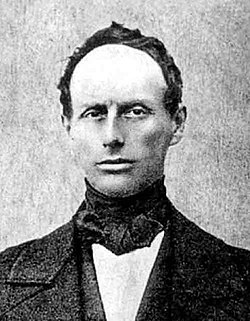Christian Doppler
rsrivastava34
Christian Doppler was an Austrian physicist and mathematician best known for his namesake scientific phenomenon - the Doppler Effect.

Personal Life
Early Life
Christian Doppler was born in Salzburg, Austria on November 29, 1803. He was born into a family of stonemasons and was one of five children. Doppler's parents, Johann and Theresia Doppler, were skeptical of their son's ability to be a stonemason due to his poor health. They also questioned his ability to succeed academically. After some consultation and counseling it was decided that young Christian was to attend the Vienna Polytechnic Institute (now the Vienna Institute of Technology). He went on to study at the University of Vienna after finishing at the Vienna Polytechnic Institute.
Life in Academia
After completing his studies, Doppler applied for a teaching position at the University of Vienna. He was appointed as an assistant professor teaching higher level mathematics. Considering his age, this was a rather lowly position so Doppler applied for a permanent professorship (tenure) at 30. While his applications were being considered, he was forced to work in a factory to make a living, since his position at the University of Vienna had been terminated.
Doppler almost left and moved to the United Stated; just as he was about to make a decision he received an offer from the Technical Secondary School located in Prague in 1835. He was not particularly happy with the position since he was only teaching basic mathematics. After some time, the school allowed him to teach higher mathematics for a few hours a week. His stint ended in 1841 when he was offered a professorship at the Vienna Polytechnic Institute. Doppler's time here was riddled with troubles. Although he dutifully carried his work, several students complained that his exams were unfair and he was therefore reprimanded. Moreover, Doppler fell into poor health during this time as well. After these troubles, Doppler was not keen on staying at the Polytechnic and was offered a position at the Academy of Mines and Forests where he could teach physics and mathematics.
By this point in his career, Doppler was gaining some traction in the world of science. After a short period of time he became the director of the Institute of Physics at Vienna University.
Family Life
Doppler married Mathilde Sturm in 1836. They had two daughters and three sons.
Death
Doppler died on March 17, 1853 in Venice of pulmonary disease. Prior to this he contracted tuberculosis which weakened him greatly.
Scientific Contributions
Doppler presented his most famous paper to the Royal Bohemian Society on May 25, 1942. His paper, On the coloured light of the double stars and certain other stars of the heavens introduced the world to the Doppler Effect for the first time. Never before had the change in a wave's frequency been related to an observer's velocity.
The Doppler Effect
We experience the Doppler Effect quite often in our everyday lives. This is most clearly seen when a fire truck or police car with sirens on drives past a stationary vehicle. The frequency of the sound wave changes in relation to the observer as the distance between the two objects changes.

Doppler was able to derive this by treating light and sound as longitudinal waves (it was later found that light is not a longitudinal wave). Doppler applied his theory to light and the manner by which we could see changes in the colors of stars on the basis of their distance to the observer.
Other Work
The Doppler Effect was the pinnacle of Christian Doppler's scientific career. He came up with several other theories, including one on electricity and magnetism, but none were as profound as what he discussed in his paper.
Other Information
Fun Facts
1. We are not sure of Doppler's full name. He went by Christian Doppler, but some records show him as Christian Andreas Doppler. 2. The Doppler effect was initially designed to work with light. Its acoustical verification was carried out by scientist Buys Ballot in 1845.
Connectedness
- How is this topic connected to something that you are interested in?
- How is it connected to your major?
- Is there an interesting industrial application?
Further reading
The Search for Christian Doppler by Alec Eden
External links
http://www.biography.com/people/christian-doppler-9277346 https://upload.wikimedia.org/wikipedia/commons/8/86/Christian_Doppler.jpg
- https://en.wikipedia.org/wiki/Doppler_effect#/media/File:Dopplerfrequenz.gif
- http://www-history.mcs.st-and.ac.uk/Biographies/Doppler.html
References
http://www.biography.com/people/christian-doppler-9277346 https://upload.wikimedia.org/wikipedia/commons/8/86/Christian_Doppler.jpg http://www.britannica.com/biography/Christian-Doppler